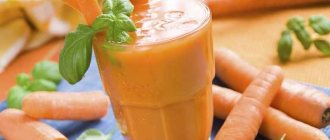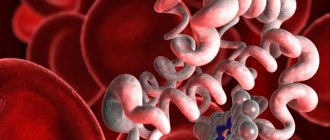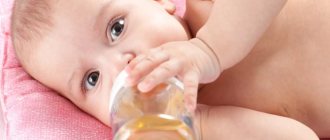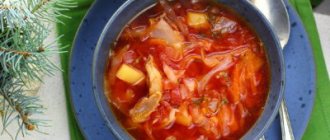According to WHO recommendations, the first complementary foods should be introduced no earlier than six months of age. But there are also exceptional cases when a baby on artificial nutrition needs vitamins and some nutrients already at the age of three months. Everything that comes to hand, of course, cannot be given to the baby. It is necessary to sensibly assess the situation and know exactly what such a baby can eat and what not. This article is also not an axiom and a guide to action for absolutely everyone. Naturally, first of all you need to consult your pediatrician.
- What should not be given at 3 months?
- What can you give a 3 month old baby to eat?
- What can you give a 3 month old baby to drink?
- Possible nutrition problems
The baby has an incredibly sensitive digestive system that can react to even the most minor changes. After all, the baby ate only formula or mother's milk, which is homogeneous in consistency, warm and liquid, and now he is offered completely unfamiliar food. Complementary foods should be introduced very gradually, starting with half a teaspoon. At the same time, the mother should carefully monitor the child’s body’s reactions to new foods.
What should not be given at 3 months?
First of all, obviously allergenic foods are excluded from the baby’s diet. It is strictly forbidden to give them to the baby even in small quantities. In fact, the list of foods allowed at this age is quite small.
At three months it is forbidden to give your child:
- any porridge, especially semolina;
- cabbage, garlic, onions, legumes;
- tomatoes, carrots, pumpkin;
- bright fruits and vegetables;
- eggs, fish, cottage cheese, meat;
- salt;
- sugar.
All the products listed in the list are too heavy for a small body. The child's digestive system is not yet ready to digest these foods. Due to the immaturity of the digestive tract, the child simply does not have enough enzymes to break down and absorb certain foods.
In addition, all of the listed products can cause gas formation and fermentation, as well as upset the child’s stool. Experimenting with food can even lead to stomach inflammation.
Especially do not salt food or add sugar to it.
What can you give a 3 month old baby to eat?
As a rule, the first complementary food is always vegetable, because it is very easily digestible and very rarely causes any negative consequences in the form of colic or allergic manifestations. Many kids enjoy eating vegetable purees , as they are smooth and uniform in consistency.
If the mother has doubts and is thinking about where to start complementary feeding and which vegetable to give first, then it is recommended to give the baby zucchini puree or mashed potatoes for the first time. Although these products are different in composition, children tolerate them very well.
You can use jarred purees from the store or make your own. It's very simple, just boil the zucchini in water for about fifteen minutes and beat it with a blender. Potatoes are a little more complicated : they need to be soaked in cold water for about half an hour to remove excess starch, and then boiled and mashed.
If the finished puree seems too thick, you can add the water in which the vegetable was cooked or dilute it with mother’s milk/formula.
When the puree has cooled to room temperature, you can give it to your baby, starting with half a teaspoon. In this case, it is recommended to give the product for the first time at the beginning of the day, so that the mother can carefully monitor the reactions of the baby’s body. If there are no reactions, then the next day you can give one teaspoon of puree and so, double the portion every day. Complementary feeding is always given to a hungry child, that is, first puree, then breast or adapted milk formula.
When the baby tries single-component vegetable purees and no reactions are detected, you can offer the baby a multi-component vegetable puree or soup. The soup is cooked in the same way as puree, but when grinding in a blender it needs to be done a little less frequently. The soup may consist of the following set of vegetables:
- zucchini,
- potato,
- broccoli,
- cauliflower.
What can you give a child to drink at the age of 3–6 years?
When the child is three years old, it is permissible to introduce a number of more drinks into the diet:
1. Hibiscus tea.
It is classified as an allergen; at a young age it is better not to get carried away with it. Drinking the drink is prohibited for children if they have gastritis, ulcers or a tendency to urolithiasis. We also note that due to acidity, it damages tooth enamel. Even adults should limit their consumption of hibiscus to a maximum of three cups per day. It is better to give the baby any other tasty tea.
2. Store-bought juices.
Now your child can be offered juices that are not intended exclusively for baby food.
3. Carbonated drinks, bottled kvass.
From the age of three, experts admit that a child can drink carbonated drinks: kvass, lemonade, Fanta. But you need to understand that the maximum volume is limited to one glass per day, and it should be given infrequently. The fact is that these liquids contain food additives, “natural-identical” dyes, flavors, carbon dioxide, benzene, and acids. They contain a lot of sugar, which, thanks to the gas, spreads faster throughout the body, increasing the immediate load on the pancreas. All this can have a negative impact on health, provoke an allergic reaction, and caries.
The listed products are not able to quench thirst; rather, on the contrary, they provoke it. Some companies, in an effort to reduce calories, replace sugar with other substances: xylitol, sorbitol, saccharin. The first provokes the formation of kidney stones, the second worsens visual acuity over time, the last is classified as a carcinogen.
We also emphasize that gas complicates processes in the intestines, causes belching, bloating, and provokes gastritis. In addition, harmful substances enter the liquid from plastic bottles. But kvass from barrels, which you can buy right on the street, in principle cannot be given to a child, since the barrels are exposed to direct sunlight all day long, get very hot, and it is difficult to say who, when and with what they wash them afterwards.
4. Oxygen cocktail.
Good for tired kids - one glass is comparable to a walk in the fresh air. The cocktail is also suitable for children with chronic diseases, young athletes, and residents of northern regions. But you need to take into account that it causes flatulence.
5. Milkshakes.
Please note that your child can drink milkshakes once or twice a week. Such frames are associated with a high sugar and fat content.
Interesting to know!
An experiment by scientists from the National Institutes of Health in the USA showed that chocolate milkshakes affect the pleasure center in the brain of schoolchildren in such a way that it causes addiction, akin to a drug.
6. Black and green tea.
Any tea – green, white, black, yellow – contains caffeine, which is completely unnecessary for a child’s body. It excites the nervous system, causing sleep problems, nightmares, and rapid fatigue. True, there is no reason to completely abandon it. Children can drink non-concentrated tea in the morning.
But you need to remember that this drink is characterized by a diuretic effect; when drinking it in large volumes, minerals can be washed out of the body. You should not give your child bagged tea with added fruits, flowers, or flavorings - it will not be beneficial. Brew loose leaf tea for children and remember that with milk the effect of caffeine on the body will be lower.
7. Honey drinks.
Honey is an undeniably valuable, healthy product; it strengthens the immune system and calms the nervous system. True, it is a source of allergies, which means that at 3–6 years old you can only put a spoonful of this sweet product in tea, and drinks containing honey are allowed only after 6 years and during the ARVI season.
8. Mineral water.
Choose table mineral water for drinking, since the doctor prescribes medicinal water only in case of specific diseases. Remove gas bubbles from sparkling water so that it is safe for your child to drink. To do this, put it on the fire for a couple of minutes or do not close the bottle for several hours.
9. Spring water.
It is better to take water from proven sources. When a child reaches three years of age, he can drink water without boiling.
10. Cucumber pickle.
When a child likes this drink, you can give it to drink, but not much, because it contains a high content of salt, which provokes thirst. Brine also has a side effect - a slight laxative effect, flatulence, which is also characteristic of fresh vegetables.
11. Hot chocolate.
Only 5-6 years old is allowed. It causes allergies more often than cocoa, which is why they start giving it to drink later.
Interesting to know!
Russian pediatricians have compiled a list of drinks that are most beneficial for children under six years of age.
- Milk takes first place. Scientists from McMaster University (USA) say that all children need a glass of milk a day to replenish micro- and macroelements in order to cope with stress and adapt more easily to external conditions.
- Second place – freshly squeezed pomegranate juice, cranberry juice. The first type of drink contains many vitamins, minerals, and has a positive effect on hemoglobin levels. But before drinking, it should be diluted with water or less sour juice. And cranberry juice, in addition to vitamins and minerals, is also rich in pectins, which rid the body of unnecessary substances. In addition, it has bactericidal properties, prevents caries, and increases mental and physical performance.
- In third place are kefir and fermented milk drinks. The child needs the calcium they contain so that teeth and bones can grow normally. Also, these drinks normalize the intestinal microflora, which is beneficial for the digestive and immune systems.
On a note!
In the West, everyone consumes 15–30 kg of yogurt per year, but in our country it is only 2.5 kg per person.
Read material on the topic: Disinfection of drinking water
Possible nutrition problems
Many babies have a noticeable decrease in appetite at three months and, most likely, this is due to the early introduction of complementary foods. There is no need to force food on your baby . If he shows in any way that he does not want to eat (closes his lips, pushes food out with his tongue, spits, cries), then under no circumstances should you insist. It is better to offer food after a while. Perhaps a new diet or a specific product somehow affects his body and it is worth reviewing his diet.
Many mothers are tormented by the question: “What should I give my child if, after taking a spoonful of any new product, he develops diathesis?” In this case, first of all, you need to seek advice from a specialist. It is quite possible that in this way the baby’s body signals that it is not ready for complementary feeding, because it is not for nothing that doctors around the world believe that there is no complementary feeding until the child reaches six months.
As a rule, the first courses of complementary feeding are introduced into the baby’s diet at about 5 months. But there are exceptions when babies on artificial or mixed feeding need additional vitamins already at the age of three months. Of course, you can’t give everything in a row; you need to know what you can give your baby to eat at 3 months. But this information is not a rule for everyone, because only the local pediatrician observing the baby should give the go-ahead for the introduction of complementary foods.
The baby’s digestive system is very sensitive to any changes, and therefore it is worth very carefully monitoring the child’s body’s reaction to the introduction of new foods. After all, until this time, the child consumed only formula and mother’s milk, a homogeneous liquid consistency, and now he will have to adapt to new food.
What should a three-month-old baby not do?
The first step is to exclude from the list of various complementary foods those that absolutely cannot be given to a baby at 3 months, and what is possible will take up very little space on our list. Prohibited at this age:
- porridge, semolina first of all;
- white cabbage, beans, onions, garlic;
- carrots, tomatoes;
- red vegetables and fruits;
- cottage cheese, eggs, meat, fish;
- sugar, salt.
All of the listed products are still too heavy for the digestive system and, in addition to fermentation and increased gas formation, can cause stool upset and even inflammation of the stomach. There is also no need to add salt or sugar to dishes and drinks for such a baby.
What can be given from vegetables from 3 months?
As a rule, the first new product a child tries after formula is vegetable complementary foods. It is easily digested in the stomach and does not cause painful colic or allergic reactions. In addition, even after a sweet mixture, children willingly eat it.
When a mother does not know what can be given to a baby at 3 months as complementary food, it is recommended to start with potatoes or zucchini. Both of these vegetables are well tolerated by infants, although they have different compositions.
It is very simple to prepare both, only the zucchini will need 15 minutes, and the potatoes will first need to be soaked in cold water to wash out the starch (about 30 minutes), and then cooked for about half an hour. Vegetables are cut into small cubes and boiled over low heat in an enamel or glass container without adding salt.
As soon as the pieces are boiled, the liquid is drained, and the main mass is crushed using a blender or simply crushed with a fork so that no lumps remain. If the puree turns out to be too thick, then it is diluted to the required consistency with the broth in which the vegetables were cooked or with mixture/expressed milk.
When the puree has cooled, you can give it to your baby a little at a time. For the first time, half a teaspoon will be enough. You need to give complementary foods in the first half of the day so that you can monitor the baby’s condition until the evening. If everything is normal, then the next day the portion is increased to one spoon, and more is added every day. It is recommended to first offer complementary foods to a hungry baby, and then supplement with the usual formula or breast milk.
Between the third and fourth months, when the baby has already tried one-ingredient puree, you should offer him a light vegetable soup with several ingredients. It is cooked in the same way as puree, but diluted to a slightly more liquid state. In addition to potatoes, zucchini, carrots, and cauliflower are added to the soup.
What can you give your baby to drink at 3 months?
In addition to the child’s main drink, which he receives from a bottle, in some cases it is recommended that the baby be given baby water. This is especially necessary in extreme heat when there is a threat of dehydration.
In addition to water, your baby can be given weak chamomile tea for children, which has a mild sedative effect, or a fennel drink, which normalizes digestion. At home, a mother can prepare apple compote for her child, but without using sugar. Additional drinks should not exceed 100 ml per day.
Energy for growth is in nutrition
Feeding a 3 month old baby is the main goal and joy in his life. The baby acquires his initial concepts of reality from the conditions in which he grows, and his first ideas about people - from the mother who feeds him. The instinct of hunger is familiar to all living beings, and especially to infants. A chronically malnourished baby will not allow himself to be left hungry; he will scream to demand the required portion of food. Usually the baby wakes up from hunger and cries most often because she wants to eat. This can be easily determined by how greedily he catches a nipple or pacifier.
The sucking process is a difficult task for a baby. He puffs, doing a difficult task, even sweats from zeal. It will not be possible to take away his source of food before he is completely satisfied, otherwise an indignant cry will tell about his appetite. Only after receiving exactly the volume of milk that is required does he quickly fall asleep. Even while sleeping, he continues to smack, as if he is dreaming of continued feeding, and you can see a manifestation of bliss on his face.
You should not force your baby to eat more milk than necessary. For this reason, he may lose his appetite. Trying to avoid excess food, he will try to fall asleep early or stubbornly refuse to breastfeed. By this he instinctively protects himself from excesses. But such a situation is fraught with loss of interest in the feeding process itself and loss of pleasure from it. Receiving food should remain bliss for the baby, and the mother should be his best friend and nurse. This is an essential factor for the baby’s confidence in the trustworthiness of others, which is established by the child’s diet at 3 months.
What can you feed a baby at three months?
Typically, the introduction of any liquids other than mother's milk or infant formula begins with special baby tea or compote. They should be given strictly before feeding and no more than twice a day. It is better to start with small volumes: literally from 10-15 grams, gradually increasing a single portion of complementary foods to 25 grams.
After successfully introducing tea into the diet, pediatricians suggest parents introduce their child to chicken yolk. He is fed just a little bit at a time so that the child can only try a new dish, and always before the main feeding with milk or formula. The dose is increased every day, and after two weeks the child can be given half the yolk at a time.
If there are clear signs that the baby is not eating enough, you can include vegetable (fruit) juices and purees in his diet. However, it is very important to avoid fanaticism here. The digestive tract of a three-month-old baby is not yet fully formed, so there is a high risk of disrupting its natural functioning.
Pear and clarified apple juices, carrot and banana purees, as well as liquid vegetable soups (zucchini, pumpkin) are best suited for such young children. You can also give decoctions of cereals, for example, from rice. However, it should be remembered that they are quite nutritious and, moreover, “heavy” for the stomach, so you should not get carried away with them.
At what age can children drink water?
Water is critical for the normal functioning of the organs and systems of our body. Its insufficient consumption immediately negatively affects the processes of digestion, assimilation of food, hematopoiesis, that is, the formation of new blood cells. And without water, heat exchange processes in the body are impossible. A child's need for fluid depends on age, type of nutrition (breastfeeding, formula, complementary foods), ambient temperature, physical activity and personal metabolic characteristics.
The total volume of fluid that a child should receive during the first year is 100–150 ml/kg body weight per day. Up to 6 months this figure is 80–130 ml/kg per day, after six months – 130–150 ml/kg, from 1–3 years – 100 ml/kg, after 3 years – 80 ml/kg per day.
Articles recommended for reading:
- Types of water filters and their characteristics
- How to install a water filter - useful tips
- How to drink water correctly: practical recommendations
Today, the World Health Organization (WHO) does not recommend giving additional fluids to children under six months old if they are breastfed and do not have special medical indications. So, it turns out that only breast milk can be drunk by a one-month-old baby.
The reason for this is the fact that breast milk plays a role in both food and drink. Foremilk, that is, what is released at the beginning of feeding, is more liquid and is 87% water. Therefore, when thinking whether children can only drink milk or need to supplement it, know that it satisfies the baby’s need for liquid. Adding water to the diet before 6 months in this case may cause a reduction in milk consumption. The fact is that due to receiving water, the baby will have a false feeling of satiety. The result will be malnutrition and weight loss.
When the baby sucks little and inactively after drinking water, this can cause a reduction in milk production by the mother’s glands. You should start feeding a breastfed baby only after you have gradually started using complementary foods.
For parents of bottle-fed or mixed-fed babies, the answer to the question of whether the child can be given additional drinks will be different. The fact is that the need to drink water appears immediately after introducing formula into the diet. After all, it is a difficult product to digest and, without supplementation, can cause problems with the gastrointestinal tract - cause constipation.
True, in some situations a child needs to drink regardless of the nutrition he receives. This should include conditions that provoke pathological loss of fluid: fever (increase in body temperature above +38 ° C), vomiting, frequent loose stools, hot, dry weather (above +25 ° C). Since it is necessary to save the baby from dehydration, in the heat it is better to give him water at shorter intervals than usual. Breastfeeding can simply be applied to the breast more often.
It is recommended to give drinks in between feedings. If you do this earlier, as already mentioned, you can create a false feeling of fullness. Give your baby food from a spoon, and when he grows up, teach him to use a sippy cup or sippy cup. Such dishes are equipped with a special valve on the back of the lid, which prevents water from leaking out even when tipped over or tilted strongly.
When drinking from a spoon, the liquid goes directly into the child’s mouth, all that remains is to swallow it. The same principle applies when drinking from a cup. Babies who are accustomed to using a bottle, where they have to make sucking movements to get water, often find it difficult to switch to a cup.
Choosing a drink for a child, especially a very young one, is not an easy task. Every mom and dad want their baby to receive nutrients from liquids. But you need to understand that there are drinks that are beneficial for adults, but at the same time harmful for children. Let's figure out what liquids and at what age children can drink.
Read material on the topic: Drinking water safety
How to introduce complementary foods into the diet of a three-month-old baby?
Any new product should be introduced into the diet of a three-month-old child in microdoses, gradually, over one to two weeks, increasing the volume of food to the recommended amount. It is necessary to differentiate in time between different types of dishes, including each new one. If an allergic reaction occurs, this will allow you to immediately determine the product that triggered it. Also, such a scheme minimizes the risk of problems with the digestive tract and reduces bloating. After feeding, the child’s behavior (is he lethargic, how does his stool change) must be analyzed.
Even liquid and semi-liquid foods should be given from a spoon. In addition to convenience, this has educational aspects: gradually the child prepares to eat thicker food. Another well-known rule: for children who are bottle-fed, all types of complementary foods begin to be given approximately one to two weeks earlier than for breast-fed infants. At the same time, the sequence and preparation scheme remains the same.
Why are complementary foods given before the main meal?
Any complementary foods should be given before the main course (adapted formula or breast milk) so that the child is as interested as possible in absorbing new foods. If the baby satisfies his hunger in the usual way, it will be very difficult to persuade him to experiment. And the process of addiction itself will be much more problematic.
For mothers whose little one, despite all the tricks, still doesn’t want to “get acquainted” with new food, the following advice will probably be useful: try mixing complementary foods with breast milk, formula or boiled water. At first, the proportions should be kept higher for the usual food, but gradually the dosages need to be changed, increasingly reducing the volume of milk/formula.
Age diet
The powerful progress that occurs in the development of a three-month-old baby requires a change in the feeding process. The basis, as before, is liquid food: the consumption of breast milk or artificial formula continues. No complementary foods are allowed into the diet from 3 months onwards. Accelerated growth and physical activity cause an increase in appetite. Because of this, a regimen that has been so laboriously established, or even one that has not yet been established, may collapse in order to resume breastfeeding on demand, which most likely will have to be increased. This is not a reason for disappointment; the incentive will be closer contact with the baby and his smile.
Observing the reaction of a 3-month-old baby gives the mother the opportunity to pay attention to signs of satiety or, conversely, lack of food. A well-fed baby slows down sucking and turns away from the breast or bottle.
By the end of 3 months, most infants begin to experience increased growth. Appetite also grows. Mothers may have the impression that she does not have enough milk, and the baby wants to eat more and more often. Some, on the contrary, turn away from the breast and become capricious. Breastfeeding is sometimes hindered by the baby's interest in the world around him, when he spins around, looking at everything around and being distracted from the breast.
Not realizing such situations, mothers turn to complementary feeding in a panic, which should not be done. The smart little one, realizing that it is much easier to get food from a bottle, completely refuses to breastfeed. This is a fairly common reason that three-month-old children switch first to mixed, and later to artificial nutrition.
In reality, there was no less milk, the baby simply increased his nutritional needs. This phenomenon is called a lactation crisis. It does not last long and goes away after a few days.
What dangers are fraught with early complementary feeding?
Finally, I would like to once again remind all mothers that complementary feeding introduced too early can lead to very unpleasant consequences. In particular, it can provoke the development of severe diarrhea and even serve as an impetus for the disease rickets. Doctors have repeatedly noted that the body of children who began to feed before the due date is less resistant to infectious diseases and suffers them more severely. Therefore, if the mother notices that there is not enough milk, or the baby begins to refuse formula milk, it is necessary to seek advice from a qualified pediatrician, and not try to solve the problem on your own.











